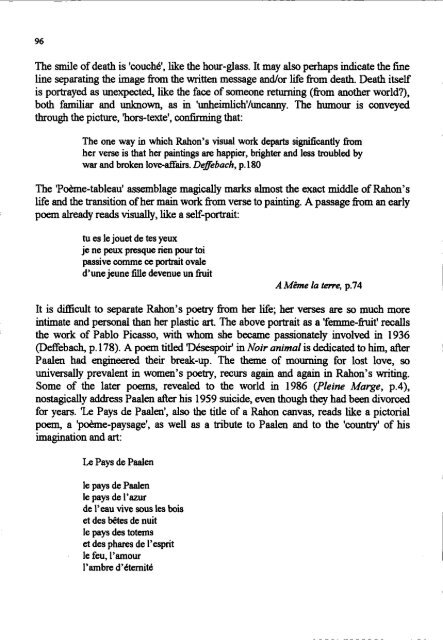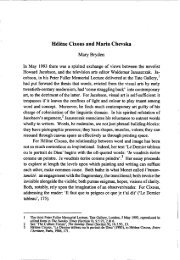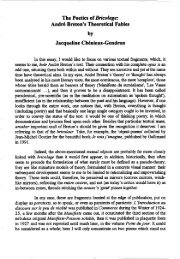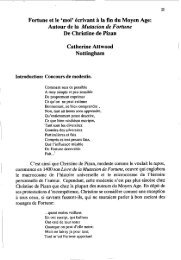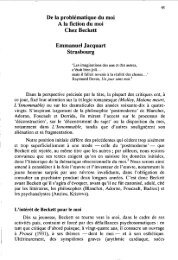Through An Hour-giass Lightly: Valentine Penrose and Alice Rahon ...
Through An Hour-giass Lightly: Valentine Penrose and Alice Rahon ...
Through An Hour-giass Lightly: Valentine Penrose and Alice Rahon ...
Create successful ePaper yourself
Turn your PDF publications into a flip-book with our unique Google optimized e-Paper software.
96<br />
The smile of death is 'couché', like the hour-glass. It may also perhaps indicate the fuie<br />
line separating the image from the written message <strong>and</strong>or life h m death. Death itself<br />
is portrayed as unexpected, like the face of someone returning (from another world?),<br />
both familiar <strong>and</strong> unknown, as in 'unhedich'/uncamy. The humour is ccmveyed<br />
through the picture, 'hors-texte', confirming that:<br />
The one way in which <strong>Rahon</strong>'s visual work deparis sigdicady from<br />
her verse is that her paintings are happier, brighîer <strong>and</strong> less troubled by<br />
war <strong>and</strong> broken love-aîïairs. Deflebach, p.180<br />
The 'Poème-tableau' assemblage magically marks almost the exact middie of <strong>Rahon</strong>'s<br />
life <strong>and</strong> the transition of her main work fì-om verse to painting. A passage h m an early<br />
poem aiready reads visually, like a seif-portrait:<br />
tu es le jouet de tes yeux<br />
je ne peux presque rien pour toi<br />
passive comme ce portrait ovale<br />
d'une jeune flle devenue un h it<br />
A Même la terre, p.74<br />
It is diíñcult to separate <strong>Rahon</strong>'s poetry h m her life; her verses are so much more<br />
intimate <strong>and</strong> personal than her plastic art. The above portrait as a 'fme-hit' recalls<br />
the work of Pablo Picasso, with whom she became passionately involved in 1936<br />
(Deffebach, p. 178). A poem titled 'Désespoir' in Noir animal is dedicated to him, &er<br />
Paalen had engineered their break-up. The theme of moeg for lost love, so<br />
universally prevalent in women's poetry, recurs again <strong>and</strong> again in <strong>Rahon</strong>'s writing.<br />
Some of the later poems, revealed to the world in 1986 (Pleine Marge, p.4),<br />
nostagically address Paalen &er his 1959 suicide, even though they had been divorced<br />
for years. 'Le Pays de Paalen', also the title of a <strong>Rahon</strong> canvas, reads like a pictorial<br />
poem, a 'poème-paysage', as weii as a tribute to Paaien <strong>and</strong> to the 'country' of his<br />
imagination <strong>and</strong> art:<br />
Le Pays de Paaien<br />
le pays de Paaien<br />
le pays de l'azur<br />
de l'eau vive sous les bois<br />
et des bêtes de nuit<br />
le pays des totems<br />
et des phares de l'esprit<br />
le feu, l'amour<br />
l'ambre d'éternité


